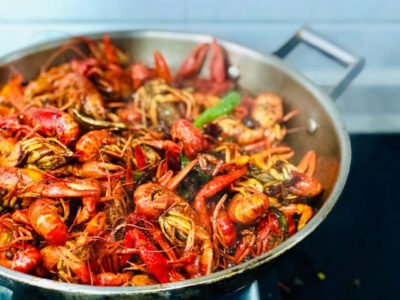
It can be tiring to try to find a meal that is satisfying and safe at the same time when you are gluten sensitive. You are always browsing menus, inquiring about ingredients, and even wondering whether that sauce or seasoning could have hidden gluten.
In a place like Hong Kong, known for dim sum, noodles, and one-dimensional soy-sauced meals, it may feel particularly restrictive. While gluten-free options are becoming more visible, most Hong Kong restaurants still treat them as part of a side menu rather than a full offering.
However, specialized venues such as Eatology are setting new standards with dedicated gluten-free kitchens. This article examines the transformation of gluten-free restaurants in Hong Kong —why they are changing, where to go, and how to explore the new world of Hong Kong cuisine with ease.
1.Growth Of Awareness and Accessibility
If you have searched for gluten-free Hong Kong restaurants, you have probably found more results than you have ever encountered. From the trendy cafes in Central to the wellness restaurants in Sai Ying Pun, the city has been highly conscious of gluten-free needs. It is no longer an insider topic that people talk about in wellness communities, but it is finding its way into mainstream discussions.
Restaurants have been putting gluten-free options on their menu, training their staff on the safety of allergens, and even dedicating separate prep areas in order to avoid cross-contamination. This progress can be explained by the rising consumerism and the growth of health consciousness in the Hong Kong food culture.
However, awareness does not mean being perfect. There are other kitchens that remain unaware of hidden sources of gluten, such as soy sauce or fryers. Thus, although the scene is growing, it is worth questioning and updating.
2.Expansion Of Cuisine Variety

There was a time when eating gluten-free in Hong Kong meant choosing between salads or simple grilled dishes. Today, that’s changing fast. Gluten-free dining has moved beyond “safe food” to include diverse, flavorful cuisine.
A few Italian restaurants now offer gluten-free pasta and pizzas made with rice flour and sorghum. Some high-end Chinese restaurants are also offering gluten-free dim sum and tamari sauces. Even some bakeries are coming up with gluten-free pastries that actually feel sinful to eat.
This development implies that you can go out to eat with your friends and have the same food experiences without sacrificing. Your diet no longer restricts you, and you can experience the vibrant Hong Kong food scene on your own terms.
3.Better Communication and Transparency

Another major shift is how restaurants handle communication. In the past, diners often faced blank stares when asking about gluten content. Today, staff in many establishments are trained to understand allergens and respond accurately.
Gluten-free labels are often posted on menus, and some restaurants even provide ingredient or preparation information. Such openness creates confidence and makes the dining experience less stressful.
That said, open communication is still essential. Always explain your sensitivity level and inquire about preparation practices. The more you discuss with the employees, the surer you will be about what is on your plate.
4.Innovative Ingredient Sourcing
Behind the scenes, the Hong Kong culinary industry is experimenting with new ingredients and techniques. With the rising demand for gluten-free foods, some suppliers are simplifying the process of providing chefs with gluten-free alternatives- such as rice, buckwheat, and corn flours, or gluten-free soy sauces.
Many cooks are reconsidering old recipes. For example, potato or tapioca starch can be substituted for wheat flour in tempura recipes, and bakeries are testing nut flours as texture and richness enhancers.
In Hong Kong, the gluten-free imports are also being increased by approximately 3.3% between 2023 and 2024. Indicating that local chefs are adapting Asian staples according to the modern dietary requirements.
5.Challenges That Still Need Solving
Even though this is a positive trend, gluten-free dining in Hong Kong will still face certain obstacles. One of the most significant problems is that of cross-contamination. The same fryers, cutting boards, or knives can be used in the same kitchen by the most scrupulous cooks to prepare gluten-containing and non-gluten-containing food.
Cost is another factor. Flours, sauces, and preparation are applied separately, which can slightly increase the price, which is why gluten-free menu items tend to be more expensive. There is also disproportionate access: the central districts are full of opportunities, while the outer neighborhoods continue to lag.
Additionally, not all menus specify gluten-free items, because some are not even fully aware of what gluten-free means. That is why one has to check and verify twice before placing an order. The scene is changing, yet it remains part of the experience of being vigilant.
6.Future Of Gluten-Free Dining In Hong Kong

Looking ahead, the Hong Kong gluten-free market is projected to grow further, giving delivery platforms and restaurants a strong incentive to adopt clearer allergen filters and dedicated gluten-free workflows.
In the region, China already accounted for about 5.1% of the global gluten-free products market revenue in 2024, and Asia-Pacific shows rapidly rising demand — trends that are beginning to influence menu innovation and ingredient sourcing across foodservice sectors. As these preferences gain traction, more mainstream restaurants are expected to offer gluten-free dishes by default rather than only upon request.
Allergen labelling and menu clarity are improving as part of a larger “clean label” movement that has reshaped consumer expectations across Asia. In fact, 68% of gluten-free buyers now say they actively avoid artificial additives even in certified products, signaling a push toward both transparency and natural ingredients.
Conclusion
Gluten-free dining in Hong Kong is evolving from a difficult pursuit into a confident, enjoyable experience. Awareness is spreading, ingredient sourcing is improving, and menus are becoming more inclusive and transparent. Yes, challenges remain—especially around cost and cross-contamination—but progress is evident.
So next time you dine out, you’ll find it easier to enjoy Hong Kong’s rich food culture without second-guessing every bite. The city is proving that going gluten-free doesn’t have to mean giving up flavor, variety, or authenticity—it simply means dining smarter, with more delicious possibilities than ever before.













